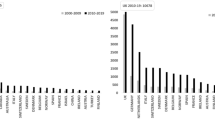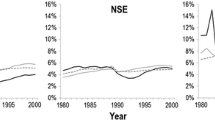Abstract
Data are presented on the scientific output from 1985–92 of the Less Favoured Regions (LFRs) of the European Community as recorded in theScience Citation Index. The use of postcodes makes it easier to identify papers from LFRs and they are now nearly universal (over 95%). LFR output has grown since 1985 from 5% to nearly 8% of the EC total, and there is much more trans-national co-authorship between ones in different countries though it is still at a low level. There is also increasing co-publication between scientists from LFRs and the rest of the EC (More Favoured Regions, MFRs), both within the same countries and trans-nationally. Selective retrieval of papers by their address keywords shows that the LFRs are relatively strong in the physical, rather than the life, sciences and that the major areas of growth in recent years have been engineering, earth/space sciences and physics.
Similar content being viewed by others
References
G. Lewison, The scientific output of the EC's Less Favoured Regions,Scientometrics, 21 (1991) 383–402.
F. Narin, E. S. Whitlow, Measurement of scientific co-operation and co-authorship in CEC-related areas of science. Commission of the European Communities, Luxembourg, (1990) EUR 12900 EN/1, 2.
H. F. Moed, R. E. de Bruin, A. Straathof, Measurement of national scientific output and international scientific co-operation in CEC-related areas of science during 1985–1990. Commission of the European Communities, Luxembourg, (1992) EUR 14581 EN.
J. M. G. Caraca, et al. Evaluation of the effects of the EC Framework Programme for Research and Technological Development on economic and social cohesion in the Community. Commission of the European Communities, Luxembourg, (1992) EUR 13994.
J. M. G. Caraca, C. Marciano da Silva, L. Massimo, R & D indicators and socio-economic cohesion,Scientometrics, 26 (1993) 293–309.
T. Higgins, Indicators of European scientific cohesion,Scientometrics, 21 (1991) 367–381.
B. K. Sen, V. V. Lakshmi, Indian periodicals in the Science Citation Index.Scientometrics, 23 (1992) 291–318. See Table 4.
F. Cano, S. Julian, Some indicators in Spanish scientific production,Scientometrics, 24 (1992) 43–59.
G. Salton,Automatic Text Processing, Addison Wesley Publishing, 1989.
R. E. de Bruin, H. F. Moed, Delimitation of scientific subfields using cognitive words from corporate addresses in scientific publications,Scientometrics, 26 (1993) 65–80.
Author information
Authors and Affiliations
Rights and permissions
About this article
Cite this article
Lewison, G. The contribution of European community less favoured region research outputs to economic and social cohesion. Scientometrics 28, 217–229 (1993). https://doi.org/10.1007/BF02016901
Received:
Issue Date:
DOI: https://doi.org/10.1007/BF02016901




